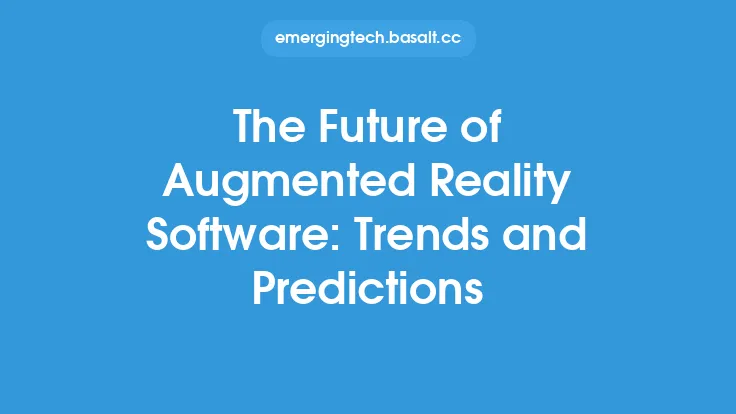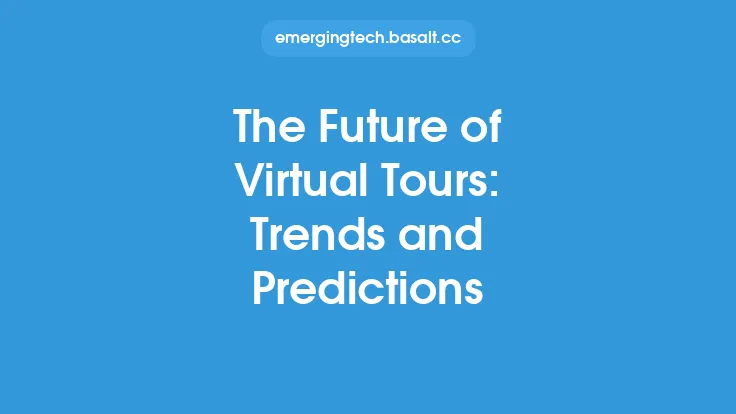The world of virtual reality (VR) is rapidly evolving, with advancements in hardware development playing a crucial role in shaping the future of this technology. As VR continues to gain traction in various industries, including gaming, education, and healthcare, the demand for more sophisticated and user-friendly hardware is on the rise. In this article, we will delve into the emerging trends in VR hardware development, exploring the latest innovations and technologies that are set to revolutionize the VR landscape.
Introduction to Virtual Reality Hardware
Virtual reality hardware refers to the physical components that enable users to experience and interact with virtual environments. This includes head-mounted displays (HMDs), controllers, sensors, and other devices that work together to create an immersive and interactive experience. The development of VR hardware is a complex process that requires careful consideration of factors such as display resolution, field of view, latency, and tracking accuracy. As VR technology continues to advance, we can expect to see significant improvements in these areas, leading to more realistic and engaging experiences.
Advances in Display Technology
One of the most critical components of VR hardware is the display technology. The display is responsible for rendering the virtual environment, and its quality can greatly impact the overall user experience. Recent advancements in display technology have led to the development of higher-resolution displays, faster refresh rates, and improved pixel density. For example, the use of organic light-emitting diode (OLED) displays has become increasingly popular in VR hardware due to their high contrast ratio, fast response time, and wide viewing angle. Additionally, the development of micro-LED displays is expected to further enhance the visual fidelity of VR experiences, offering even higher resolution, faster refresh rates, and lower latency.
Tracking Systems and Motion Controllers
Tracking systems and motion controllers are essential components of VR hardware, enabling users to interact with virtual objects and environments in a natural and intuitive way. Recent advancements in tracking technology have led to the development of more accurate and reliable systems, such as inside-out tracking and optical tracking. These systems use cameras and sensors to track the user's head and hand movements, allowing for more precise and responsive interaction with virtual objects. Motion controllers, such as those using inertial measurement units (IMUs) and electromyography (EMG) sensors, are also becoming more sophisticated, enabling users to perform complex actions and gestures in virtual environments.
Emerging Trends in VR Hardware Development
Several emerging trends are expected to shape the future of VR hardware development. One of the most significant trends is the development of standalone VR headsets, which do not require a connection to a PC or console. These headsets are powered by mobile processors and offer greater portability and convenience. Another trend is the use of advanced materials and manufacturing techniques, such as 3D printing and carbon fiber, to create lighter, more comfortable, and more durable VR hardware. Additionally, the development of advanced sensors and tracking systems, such as those using artificial intelligence (AI) and machine learning (ML) algorithms, is expected to further enhance the accuracy and responsiveness of VR interactions.
The Role of Artificial Intelligence in VR Hardware Development
Artificial intelligence is playing an increasingly important role in VR hardware development, enabling the creation of more sophisticated and adaptive VR experiences. AI algorithms can be used to optimize VR rendering, predict user behavior, and enhance tracking accuracy. For example, AI-powered tracking systems can use machine learning algorithms to learn the user's movement patterns and preferences, allowing for more accurate and responsive tracking. Additionally, AI can be used to generate realistic virtual environments and characters, creating more immersive and engaging experiences.
The Future of Virtual Reality Hardware
As VR technology continues to evolve, we can expect to see significant advancements in hardware development. The development of more sophisticated display technologies, tracking systems, and motion controllers will enable the creation of more realistic and interactive VR experiences. The use of advanced materials and manufacturing techniques will lead to the creation of lighter, more comfortable, and more durable VR hardware. Additionally, the integration of AI and ML algorithms will enable the creation of more adaptive and responsive VR experiences. As VR hardware continues to improve, we can expect to see increased adoption in various industries, including gaming, education, and healthcare, leading to new and innovative applications of this technology.
Challenges and Limitations
Despite the rapid advancements in VR hardware development, there are still several challenges and limitations that need to be addressed. One of the major challenges is the high cost of VR hardware, which can make it inaccessible to many users. Additionally, the complexity of VR hardware can make it difficult to use and set up, particularly for novice users. Furthermore, the limited content availability and lack of standardization in VR hardware can create compatibility issues and limit the user experience. Addressing these challenges will be crucial to the widespread adoption of VR technology.
Conclusion
The future of virtual reality is exciting and rapidly evolving, with advancements in hardware development playing a crucial role in shaping the industry. As VR technology continues to advance, we can expect to see significant improvements in display technology, tracking systems, and motion controllers. The integration of AI and ML algorithms will enable the creation of more adaptive and responsive VR experiences. While there are still challenges and limitations that need to be addressed, the potential of VR technology is vast, and its applications are expected to expand into various industries, leading to new and innovative uses of this technology. As VR hardware continues to improve, we can expect to see increased adoption and a more immersive and interactive user experience.




